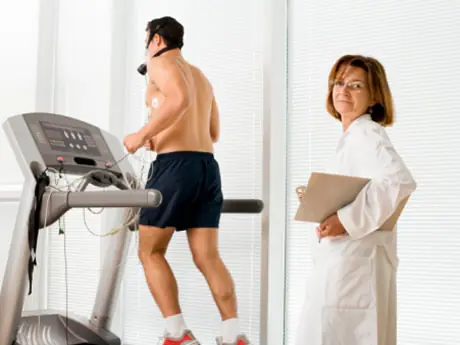
Triangle pose is known as Trikonasana in Sanskrit—tri meaning three and kona meaning corner. Triangle is a therapeutic pose that provides many benefits including strengthening of the core and legs.
How To: Triangle Pose
Starting from standing mountain pose, turn sideways on your mat. Walk or jump your feet apart approximately the length of one of your legs--this usually works out to be about three or four feet apart. Look down at your feet, your left big toe should line up exactly with your right big toe to ensure your hips are in perfect alignment.
Turn your right toe out 90 degrees and turn your left foot in about 45 degrees. Make sure you have a full external rotation of the right thigh so your right knee is aligned directly over the right foot. This means the rotation of your right leg comes from the hip joint, not the ankle joint. Lift your arms up and extend them out directly from your shoulders, arms parallel to the floor and palms facing the floor. Take a deep breathe and drop your shoulders away from your ears.
Extend your torso to the right directly over the right leg. Imagine your body is between two panes of glass. Bend from the hip, not the waist. Keep activating and pressing down through the outer left foot to secure your pose and lengthen your body. Imagine that the right side of your body is just as long as the left—don’t not crunch up the right side to go deeper. Slide the back of the right hand down the inner right shin until you feel resistance, then stop and hold. Do not hold on to your ankle, doing that deactivates your abdominal muscles, causing you to sink your right shoulder into your right ear.
You want to maintain a feeling of pressing the back of your hand against the inner right leg and at the same time pressing back against the hand with the right shin. Drop the right side of your body (shoulder and torso) and open your left body. Your head should be held neutral, making sure not to drop it out of alignment. If you want to go deeper, you can turn your head and gaze at your left hand. The goal is to feel long and extended and still be able to breathe.

Benefits of Triangle Pose
Done properly and consistently, there are many benefits to triangle pose:
- Stretches legs, muscles around the knee, ankle joints, hips, groin muscles, hamstrings, calves, shoulders, chest and spine
- Strengthens legs, knees, ankles, abdominals, obliques and back
- Stimulates function of abdominal organs
- Relieves stress
- Improves digestion and constipation
- Helps to alleviate back pain and symptoms of menopause
- Used therapeutically for anxiety, infertility, neck pain and sciatica
For the lay person or yogi, triangle pose is a great back and core strengthener. The rigors of everyday life have a tendency to weaken our backs. Because it is also a gentle twist, it helps our newly strong back stay supple and flexible, helping to stave of detrimental effects of arthritis and osteoporosis. It works the spine from your sacrum (base) all the way to the top of the neck. The twisting action also acts as a massage to our internal organs, helping them to remain in top function and maintain their ability to rid toxins. We could all use a little help with detox in this world of chemicals and fumes.
For the athlete, this pose is also great for strengthening the core and back. Having a strong yet flexible core and back is a quality many sports require. Think about the actions of a soccer player, changing direction on the field every second. And hockey players require powerful abs, an equally strong back and flexibility for their ever-changing directions. Another reason athletes should practice triangle is because of its ability to open the muscles in the groin area, which is a spot of great vulnerability for any athlete. Since this is a standing pose, it also calls on the body’s balance, which is an obvious attribute athletes looks for. Finally, the positioning of the legs in triangle requires a sturdy ankle. Keeping your ankle with the right balance of stretch and openness will decrease the likelihood of twists and sprains.
Although you should always consult your physician and research a properly-trained teacher before starting a yoga practice, there are a few instances where you should avoid this pose entirely. If you:
- Are experiencing diarrhea
- Are suffering from eye strain, varicose veins or extreme fatigue
- Are suffering from low blood pressure
- Have heart conditions, high blood pressure or diagnosed neck problems.
Have fun exploring this pose and learning about your body.
Gwen Lawrence has been a practicing fitness professional since 1990. Her current practice includes private massage and yoga training, yoga class instruction and sports yoga training. Gwen’s unique combination of dance, massage and yoga training, coupled with her extensive knowledge of anatomy, nutrition and homeopathy, provide her clients and class participants with overwhelming benefits. Gwen is the yoga instructor for several New York Yankees baseball players, team yoga instructor for the New York Giants football team, the New York Redbulls soccer team and the Pace University baseball team. Visit her website at www.yogawithgwen.com .








Discuss This Article